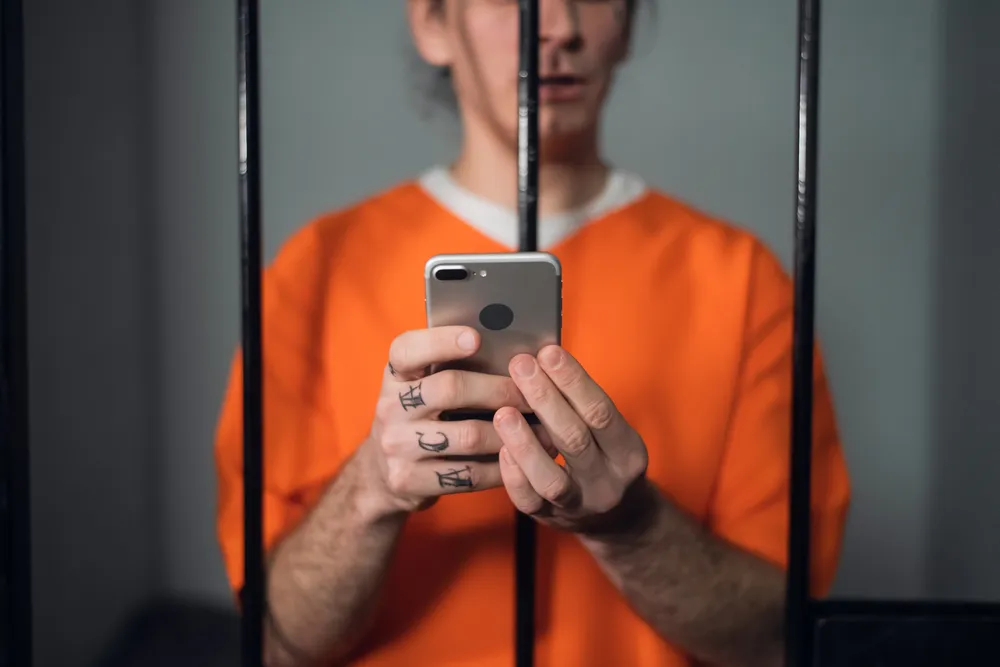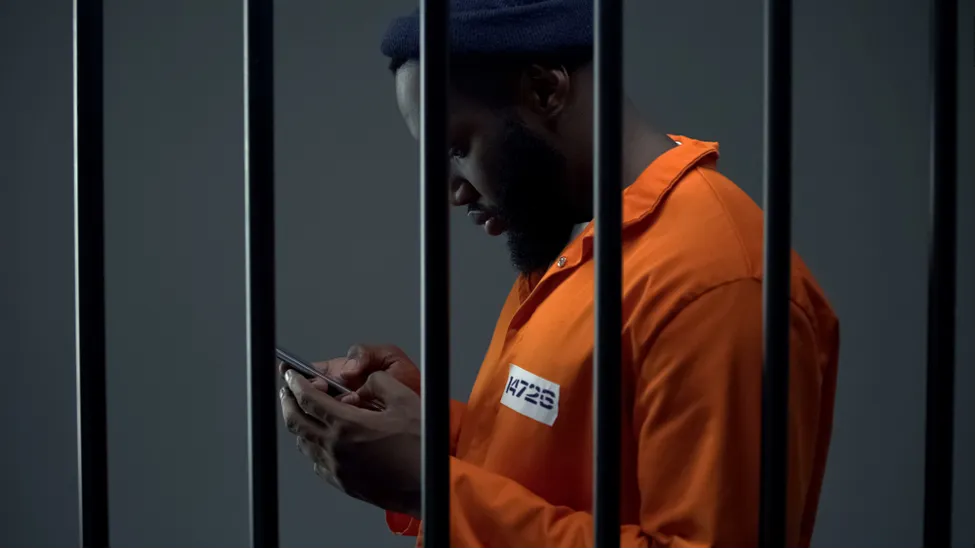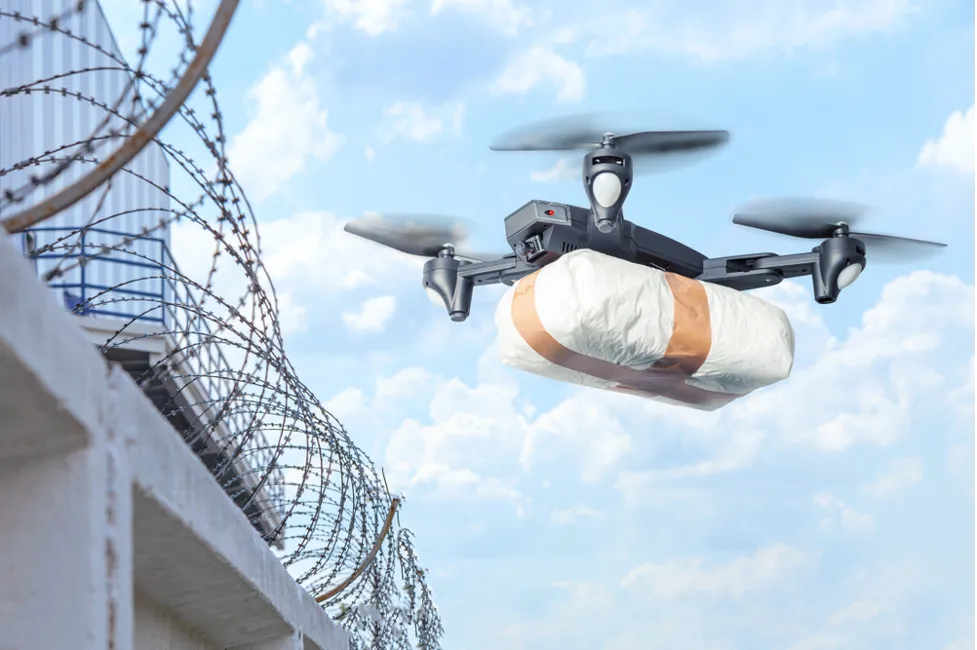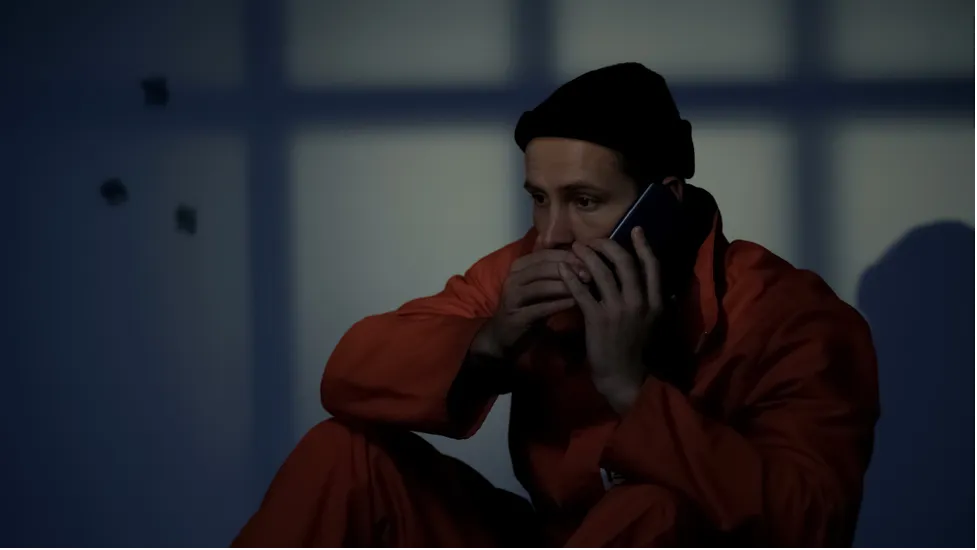Cells in the Cells: Inmates Use Contraband Phones To Commit Crimes in Communities

It isn’t just your 14-year-old daughter who feels the need to be constantly in touch with the outside world via a cell phone. Incarcerated individuals have the same obsession. Intercepting, interdicting, interfering with and investigating the acquisition of cell phones is a major undertaking in the nation’s prisons – and for good reasons.
Inmates have used illegal cell phones to stay in touch with loved ones on the outside. As the Daily Muck recently reported, drones deliver these and other contraband.
Inmates also use these phones to commit crimes from the comfort and security of their prison cells. The actions range from murder (as the Daily Muck reported on Nov. 4) to sextortion, drug operations and other criminal enterprises.
A Few Examples
The case of South Carolina inmate Dexter Lawrence is one example of sextortion from behind bars. Lawrence was serving 22 years for armed robbery and carjacking when he began using smartphones to target U.S. soldiers, the U.S. Attorney’s Office announced in April 2023.
From March 2016 to May 2017, Lawrence and his co-conspirators accessed dating sites with contraband cell phones to victimize at least 25 service members.
After the stage was set, Lawrence and others called the victim and pretended to be the outraged father of an underage girl. The “father” would tell the soldier the photos of his “daughter” were “child pornography” because she was underage.
The fraudsters threatened to have the men arrested or dishonorably discharged if they weren’t paid. Victims transferred over $60,000 to Lawrence during the 14-month scheme.
“Contraband cell phones enable inmates to continue their criminal activity behind bars,” U.S. Attorney Adair F. Boroughs said in a press release. “In this case, the defendant used them to prey on victims who have bravely served our nation. Our office is committing to working with SCDC and our law enforcement partners to address the threats posed by smartphones in our prisons.”

Another Palmetto State case cost its victim more than a few thousand dollars. In this case, the tentacles of crime stretched all the way to Michigan. The teenage victim committed suicide at the thought of his dalliance with an online “girl” becoming public.
The “girl” was Glenn Daeward Boyd, sitting in his cell at Kerward Correctional Institution in South Carolina. Boyd is a habitual offender. His crimes include manslaughter, assault/battery, assaulting a prison employee and inciting a riot.
Boyd had 10 prior disciplinary actions for violating the no-phones rule, the Daily Muck reported in its May 2024 article.
How Big Is the Problem?
Contraband cell phones in prisons pose serious security threats. Several research studies have examined the extent of the problem.

SOC, a global security firm, reported in September 2024 that up to 25 percent of inmates in U.S. prisons have contraband cell phones.
“The use of contraband cell phones in correctional facilities is a prevailing issue causing significant threats to the safety of the general public, facility staff, and inmates,” SOC Vice President Travis Berrier wrote. “The reality is, it’s difficult to keep phones from being smuggled into prisons, and there are many contraband devices out there.”
Berrier echoed the sentiments of other corrections and law enforcement officials, noting, “Mobile devices can be used for many negative and nefarious purposes, and incarcerated individuals are using phones and other devices to continue illegal activity. This includes soliciting acts of violence against members of the public or public officials and even undermining facility security to organize riots or escape attempts.”
Virtual Escapes
Cell phones in prisons have been a recognized threat for many years. As technology improved, the threat increased. Prisons separate the predators from their prey. Cell phones allow those predators to “virtually” escape their cages to continue preying on society.

A February 2011 article by the National Institute for Justice (NIJ) said this “widespread technology that allows people to connect with anyone, anywhere, has created concerns for corrections officials. The use of inexpensive, disposable cell phones has changed the age-old cat-and-mouse game of controlling whom incarcerated persons communicate within the outside world and is creating serious problems for public safety officials.”
The NIJ noted that cellular phones in the 1990s were “larger and heavier and had audio capabilities only. Today, they are lightweight, can be thinner than a matchbook, and can send both audio and data, including written messages and streaming video.
“Although these advances are welcome in society in general, they have had a negative impact on the law enforcement community, as criminals have taken advantage of cellular technology to conduct illegal activities.”
A Criminal ‘Air Force’
Drones have become a prison security problem. In a 2022 article, NIJ said those threats include:
- Smuggling Payloads: Drones can transport/drop contraband into correctional facilities. This is the most common use of drones. Most payloads are only a few pounds, but some can carry hundreds of pounds.
- Intentional Disruption: Drones create a distraction while contraband comes in another way.
- Surveillance and Reconnaissance: Drones watch an area to identify safe drop zones. They can also “case the joint” for possible security weaknesses for an escape plan.
Drones have become a “criminal air force,” providing outside support to those serving time inside the nation’s prisons.
“Successful strategies to reduce contraband entering correctional facilities combine technology-based solutions with associated policies and procedures,” the abstract of that report states. “Technical complexities, legislative constraints, rules, and regulations limit correctional agencies’ options when planning regulations to counter the use of drones to facilitate providing contraband to inmates.”
Drones Are Getting Better
The NIJ said, “Novel and inventive methods are constantly being developed and employed by persons who are incarcerated and conspirators to smuggle contraband into correctional facilities. Efforts are enabled by the constantly evolving capabilities associated with new technologies being deployed in drone designs and associated capabilities and software.”

Some modern drones can fly for 120 minutes (two hours), have a range of 18.6 miles and “imaging with 4 times higher resolution than conventional HD imaging,” the report states.
The use of drones (“Unmanned Aircraft Systems”) has been increasing. The NIJ said the Department of Justice reported 130 drone incidents from 2015-2019. It believes the actual number was much higher.
The NIJ noted the Bureau of Prisons did not establish a formal reporting policy until 2018. After implementing that policy, the number of incidents “increased by 87 percent.”
The report relied on visual observations of drones by staff. Factors like weather, time of day and line of sight affect visual identification. It said drones flying 400 feet above ground are almost invisible to the naked eye and inaudible to the human ear.
“In every case where UAS (drone) detection equipment was installed, the number of UAS flights seen in the area increased substantially,” the report states. This detection technology was not used in the 2015-2019 reporting period “and therefore reinforces the assertion that the recorded incidents are well below actual events.”
The report warns that “drones present a new and evolving security threat to a significant percentage of the 7,100 federal, state, local, tribal, and military prisons and jails in the United States. As a result, drone detection systems are emerging to help manage the threat of contraband to correctional facilities.”
Summarizing the Problem
The NIJ report summed up the problem in three points.
The threat from drones is “escalating with the evolution of the technology, which enables drone operators to carry larger payloads, fly faster and for longer distances,” and are becoming less expensive. The extent of the threat is unknown “because the capability to measure and detect drone incursions is an emerging field.”
Drone-detection technology is “rapidly evolving as companies develop new products to serve expanding defense and security applications, including correctional institutions,” the study says. However, much of that work has military applications that “do not meet the operational needs of corrections.”
As with cell phones, the federal government’s own rules limit what it can do to combat drones. “Some detection technologies are not appropriate, and interacting with drones may not be permitted under current laws unless supported by an authorized federal entity,” the NIJ said.
The report says prisons have “yet to develop a set of operational requirements to drive the development of detection technology.”
States Urge Federal Action
In most cases, federal law prohibits the use of “jammers” to interrupt cell phone use. The reason is obvious: a machine can’t tell a legal use from an illegal one.
The FCC has amended its rules. The cell phone industry has developed non-jamming options to put a crimp in criminal communications. The federal government’s love affair with red tape and proper procedures still presents problems.

It’s a case of what’s good for the goose (us) is also good for the gander (the inmates). Amping up a cell phone jammer in the prison would also prevent a guard from calling his wife to tell her he’ll be a little late for dinner but not to worry. It could also interfere with a staff member calling to report an emergency situation.
Georgia Attorney General Chris Carr is an outspoken critic of the FCC’s approach to cells in the cells.
“The easiest way to protect the public from the harms caused by contraband cell phones is to allow for the use of cell phone jamming technology in prisons and jails,” Carr said in a June 2024 press release, “but the FCC continues to block our efforts. This outdated guidance limits legitimate law enforcement tools, presents dangerous conditions for correctional officers, and allows for the escalation of criminal networks both inside and outside prison walls.
“We’re committed to combatting violent crime wherever it occurs,” he continued, “which is why we continue to call on the federal government to remove this substantial barrier to public safety.”
The press release reports Georgia prisons confiscated 8,074 cell phones in 2023 and had recovered 5,482 by June 2024.
Carr cited three especially heinous cell phone-aided acts by imprisoned criminals. One was a Georgia inmate who ordered the murder of an 88-year-old veteran. Another was a North Carolina gang leader who ordered the kidnapping of a prosecutor’s father. California prison gangs used cell phones to order murders within the prison system and to traffic drugs, Carr said.
“There are hundreds of examples from across the country of how a contraband cell phone in the hands of an inmate can be used as a deadly weapon and gives them the ability to continue their criminal enterprise,” Georgia Corrections Commissioner Tyrone Oliver said in that press release. “We are incensed by the lengths these individuals go to in continuing those activities and endangering the public. As attempts to infiltrate our facilities with contraband cell phones evolve, access to jamming technology is paramount in our efforts to combat those attempts.”
States Take Action
Eliminating cells in the cells is not a state problem, not a regional problem and not a federal problem. As with most solutions, it takes cooperation and commitment from all parties to make it work.
South Carolina– with two cases highlighted in this article– has taken steps to end cell phones in its prisons. Gov. Henry McMaster signed a law in October making it a crime for an inmate to have any telecommunication device in a state prison.
“Cell phones are very dangerous in an inmate’s hands,” state DOC Director Bryan Stirling said. “Today marks a milestone for the South Carolina Department of Corrections as we take a huge step forward by signing this bill. It has always been against our rules, but now it is against the law.”
The law is called the Capt. Robert Johnson Act. Johnson was a contraband officer at Lee Correctional Institution in 2010 when inmates used a cell phone to order an unsuccessful hit on him. He was shot and wounded in his home.

“I’m overjoyed,” Johnson said in the press release. “I think we need to do all we can to stop inmates from having access to contraband phones and to help support our correctional staff. I thank them for pushing the legislation through.”
McMaster said using cell phones to commit crimes inside and outside of prison “has been a serious threat that has had devastating consequences for innocent people across our state.”
The law also applies to handheld radios, two-way pagers, laptop computers and components of these devices.
Before this law, an inmate caught with a cell phone faced penalties such as loss of canteen or visitation privileges. They now face a one-year sentence for a first offense and up to five years for a second offense.
“If the device is used in the commission of a felony, the offender may face an additional 10 years of imprisonment if the court finds that the device facilitated the crime,” the governor’s press release states.
The “criminalization” of contraband cell phones by inmates is part of the state’s campaign to eradicate cell phones in prisons.
The FCC gave permission to South Carolina to use a first-in-the-nation Cell Phone Interdiction program in July 2023. Wireless providers disabled 1,500 cell phones in the first 15 months of operation.
What To Do and How To Do It
The FCC revised its cell phone rules in July 2021. The shining star in that constellation of policies, procedures and protocols is the “Managed Access System (MAS).” This allows prisons to work with cell phone service providers to shut down individual phones in the prison.
It’s like what happens when you forget to pay your monthly cell phone bill.
“MAS Evolved systems are designed to work with wireless networks that use advanced 4G and 5G technologies,” the FCC report explains. “A MAS Evolved system becomes a roaming partner to the network it monitors and blocks calls by keeping them from authenticating on the network — just as any network would block a device without appropriate credentials.”
There are still many “old school” methods used to combat contraband material. Those include walk-through metal detectors, handheld metal detectors, X-rays, surveillance cameras and trained dogs to sniff out targeted materials. There’s also the hands-on approach of pat searches, strip searches, cell searches and using informants to find and stem the flow of illegal items.
Managed Access vs. Jamming
Many might be tempted to jump on Team Georgia’s side of this issue and make cell phone jammers a standard part of the furnishings in our prisons.
Slap, slap. Problem solved.
Critics say there is sound reasoning for the saying, “If it sounds too good to be true, it probably is.”

In a July 2017 report, the NIJ said an MAS can work even when “surprise searches, cellphone sniffing dogs, and metal detectors” are defeated by enterprising inmates.
“Rather than relying on keeping contraband phones out of a facility, managed access systems can keep those phones from being used,” the report says.” The systems allow calls from approved phone numbers while blocking calls to and from devices or numbers that are not approved.
“Unlike jamming, managed access denies service to a select group of users, rather than to all users, and the technology is unable to stop the use of Wi-Fi to access the internet,” the NIJ continued. “Even so, loss of the ability to make calls or send text messages has the potential to make the contraband cellphones less valuable and reduce demand.”
It allows nearby commercial cellular networks “to capture transmissions from cellular user devices. Once captured, unique identifying information is compared against a list of known authorized devices, and only transmissions from devices on this ‘white list’ may go through.”
Sounds like game over for the bad guys, right? Nope.
The report says an MAS requires FCC approval and carrier consent and has “the potential to cause interference outside of the prison or to adjacent bands unless properly designed.”
The NIJ cited some pilot programs faced “challenges in fine-tuning the signal, refining the approved devices list, and establishing good working relationships with commercial carriers.”
Another problem is that prisons are “made from materials that block and reflect signals in ways that are difficult or impossible to predict, creating ‘holes’ in network coverage.” Facilities also must “harden managed access system hardware and associated infrastructure to prevent damage, system failure, and system inefficiencies from both inclement weather and premeditated attacks by incarcerated persons.”
Despite these issues, the NIJ says this technology appears “to stop a significant number of calls and text messages from going through. Managed access systems are not a be-all and end-all solution, but rather are one more piece of the puzzle to mitigate contraband cellphone usage.”
No Jam, Please
If you think this issue only involves the DOJ and the BOP, you need to add a few more letters to your alphabet soup. The FAA deals with flying drones. The DOD is also party to that issue. Since it involves cell phones and communications, the FCC is a major actor in this drama.
“The FCC has made it a top priority to put an end to illegal cell phone use by inmates in prisons,” the commission asserted in an online article entitled “Putting an End to Illegal Cell Phone Use in Prisons.”
“Contraband cell phones have been used by inmates to arrange the murder of witnesses and public safety officers, traffic in drugs, and manage criminal enterprises. This illegal practice jeopardizes the safety of America’s communities and public safety officials,” the article states.
The FCC said, “Cell phone jamming technology is illegal and causes more problems than it solves.” The agency says jamming can interfere with 911 calls and public safety communication.
The agency said it has “relentlessly pushed to identify new technology solutions to legally and effectively address this urgent problem. Working extensively with the state correctional officials, federal partners, wireless carriers, and technology vendors, the FCC has helped test and trial new technologies in a number of states with great success.”
An “inmate call capture” system tested at a Mississippi prison allowed 911 and authorized calls to go through while rejecting unauthorized calls.
“At its first trial in the correctional facility in Parchman, Mississippi, this technology stopped 216,000 illegal calls made by and to inmates from ever reaching their destination in just one month,” the report claimed.
Part of Their Debt
Maybe inmates only want a cell phone to contact their families or play online games to pass the time while they serve their sentences. However, separation from loved ones and hours of boredom are part of the costs of paying their debt to society for their crimes.

It defeats the purpose of sending your rebellious child to his room without supper if you let him take a few peanut butter and jelly sandwiches and a soft drink with him.
The good news is there are several federal, state and private commercial entities working to prevent future tragedies. Some may say that is also bad news because there are so many “cooks in the kitchen.”
Whether it’s loss of reputation, loss of money or loss of life, the cell phone-aided victimization of innocent Americans by incarcerated criminals should never happen again. It is up to the various government and commercial authorities to make sure it doesn’t.
Subscribe to The Daily Muck for more in-depth features and articles on important issues.
Discover More Muck
Why George Floyd Got Justice But Jonathan Rodgers Got Forgotten
Report John Lynn | Aug 27, 2025

Card Cracker Turned Carjacker Sentenced to Six Years
Report Strahinja Nikolić | Feb 28, 2025

Weekly Muck
Join the mission and subscribe to our newsletter. In exchange, we promise to fight for justice.
Weekly
Muck
Join the mission and subscribe to our newsletter. In exchange, we promise to fight for justice.





